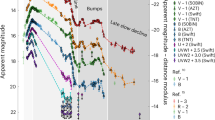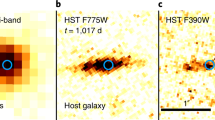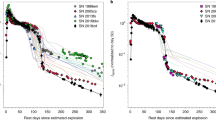Abstract
Stars with initial masses such that 10 ≤ Minitial ≤ 100
≤ Minitial ≤ 100 , where
, where  is the solar mass, fuse progressively heavier elements in their centres, until the core is inert iron. The core then gravitationally collapses to a neutron star or a black hole, leading to an explosion—an iron-core-collapse supernova1,2. By contrast, extremely massive stars with Minitial ≥ 140
is the solar mass, fuse progressively heavier elements in their centres, until the core is inert iron. The core then gravitationally collapses to a neutron star or a black hole, leading to an explosion—an iron-core-collapse supernova1,2. By contrast, extremely massive stars with Minitial ≥ 140 (if such exist) develop oxygen cores with masses, Mcore, that exceed 50
(if such exist) develop oxygen cores with masses, Mcore, that exceed 50 , where high temperatures are reached at relatively low densities. Conversion of energetic, pressure-supporting photons into electron–positron pairs occurs before oxygen ignition and leads to a violent contraction which triggers a nuclear explosion3,4,5 that unbinds the star in a pair-instability supernova. Transitional objects with 100
, where high temperatures are reached at relatively low densities. Conversion of energetic, pressure-supporting photons into electron–positron pairs occurs before oxygen ignition and leads to a violent contraction which triggers a nuclear explosion3,4,5 that unbinds the star in a pair-instability supernova. Transitional objects with 100 < Minitial < 140
< Minitial < 140 may end up as iron-core-collapse supernovae following violent mass ejections, perhaps as a result of brief episodes of pair instability, and may already have been identified6,7,8. Here we report observations of supernova SN 2007bi, a luminous, slowly evolving object located within a dwarf galaxy. We estimate the exploding core mass to be Mcore ≈ 100
may end up as iron-core-collapse supernovae following violent mass ejections, perhaps as a result of brief episodes of pair instability, and may already have been identified6,7,8. Here we report observations of supernova SN 2007bi, a luminous, slowly evolving object located within a dwarf galaxy. We estimate the exploding core mass to be Mcore ≈ 100 , in which case theory unambiguously predicts a pair-instability supernova. We show that >3
, in which case theory unambiguously predicts a pair-instability supernova. We show that >3 of radioactive 56Ni was synthesized during the explosion and that our observations are well fitted by models of pair-instability supernovae9,10. This indicates that nearby dwarf galaxies probably host extremely massive stars, above the apparent Galactic stellar mass limit11, which perhaps result from processes similar to those that created the first stars in the Universe.
of radioactive 56Ni was synthesized during the explosion and that our observations are well fitted by models of pair-instability supernovae9,10. This indicates that nearby dwarf galaxies probably host extremely massive stars, above the apparent Galactic stellar mass limit11, which perhaps result from processes similar to those that created the first stars in the Universe.
This is a preview of subscription content, access via your institution
Access options
Subscribe to this journal
Receive 51 print issues and online access
$199.00 per year
only $3.90 per issue
Buy this article
- Purchase on Springer Link
- Instant access to full article PDF
Prices may be subject to local taxes which are calculated during checkout



Similar content being viewed by others
References
Smartt, S. J. Progenitors of core-collapse supernovae. Annu. Rev. Astron. Astrophys. 47, 63–106 (2009)
Gal-Yam, A. & Leonard, D. C. A massive hypergiant star as the progenitor of the supernova SN 2005gl. Nature 458, 865–867 (2009)
Rakavy, G. & Shaviv, G. Instabilities in highly evolved stellar models. Astrophys. J. 148, 803–816 (1967)
Barkat, Z., Rakavy, G. & Sack, N. Dynamics of supernova explosion resulting from pair formation. Phys. Rev. Lett. 18, 379–381 (1967)
Heger, A. & Woosley, S. E. The nucleosynthetic signature of population III. Astrophys. J. 567, 532–543 (2002)
Woosley, S. E., Blinnikov, S. & Heger, A. Pulsational pair instability as an explanation for the most luminous supernovae. Nature 450, 390–392 (2007)
Smith, N., Chornock, R., Silverman, J. M., Filippenko, A. V. & Foley, R. J. Spectral evolution of the extraordinary type IIn supernova 2006gy. Preprint at 〈http://arxiv.org/abs/0906.2200〉 (2009)
Miller, A. A. et al. New observations of the very luminous supernova 2006gy: evidence for echoes. Preprint at 〈http://arxiv.org/abs/0906.2201〉 (2009)
Kasen, D., Heger, A. & Woosley, S. The first stellar explosions: theoretical light curves and spectra of pair-instability supernovae. Proc. Am. Inst. Phys. Conf. 990, 263–267 (2008)
Waldman, R. The most massive core-collapse supernova progenitors. Astrophys. J. 685, 1103–1108 (2008)
Figer, D. F. An upper limit to the masses of stars. Nature 434, 192–194 (2005)
Filippenko, A. V. Optical spectra of supernovae. Annu. Rev. Astron. Astrophys. 35, 309–355 (1997)
Kasen, D. N. Aspherical Supernovae. PhD thesis, Univ. California, Berkeley (2004)
Agnoletto, I. et al. SN 2006gy: was it really extraordinary? Astrophys. J. 691, 1348–1359 (2009)
Drake, A. J. et al. First results from the Catalina Real-Time Transient Survey. Astrophys. J. 696, 870–884 (2009)
Cenko, S. B. et al. The collimation and energetics of the brightest Swift gamma-ray bursts. Preprint at 〈http://arxiv.org/abs/0905.0690〉 (2009)
Mazzali, P. A., Nomoto, K., Patat, F. & Maeda, K. The nebular spectra of the hypernova SN 1998bw and evidence for asymmetry. Astrophys. J. 559, 1047–1053 (2001)
Langer, N. et al. Pair creation supernovae at low and high redshift. Astron. Astrophys. 475, L19–L23 (2007)
Young, D. R. et al. Two peculiar type Ic supernovae in low-metallicity, dwarf galaxies. Astron. Astrophys. (submitted)
Umeda, H. & Nomoto, K. How much 56Ni can be produced in core-collapse supernovae? Evolution and explosions of 30–100 stars. Astrophys. J. 673, 1014–1022 (2008)
Bromm, V. & Larson, R. B. The first stars. Annu. Rev. Astron. Astrophys. 42, 79–118 (2004)
Tremonti, C. A. et al. The origin of the mass–metallicity relation: insights from 53,000 star-forming galaxies in the Sloan Digital Sky Survey. Astrophys. J. 613, 898–913 (2004)
Law, N. M. et al. The Palomar Transient Factory: system overview, performance and first results. Publ. Astron. Soc. Pacif. (in the press); preprint at 〈http://arxiv.org/abs/0906.5350〉 (2009)
Rau, A. et al. Exploring the optical transient sky with the Palomar Transient Factory. Publ. Astron. Soc. Pacif. (in the press); preprint at 〈http://arxiv.org/abs/0906.5355〉 (2009)
Young, D. R. et al. Core-collapse supernovae in low-metallicity environments and future all-sky transient surveys. Astron. Astrophys. 489, 359–375 (2008)
Oke, J. B. et al. The Keck Low-Resolution Imaging Spectrometer. Publ. Astron. Soc. Pacif. 107, 375–385 (1995)
Miller, A. A. et al. The exceptionally luminous Type II-linear supernova 2008es. Astrophys. J. 690, 1303–1312 (2009)
Perets, H. B. et al. A new type of stellar explosion. Preprint at 〈http://arxiv.org/abs/0906.2003〉 (2009)
Foley, R. J. et al. SN 2008ha: an extremely low luminosity and exceptionally low energy supernova. Astron. J. 138, 376–391 (2009)
Pun, C. S. J. et al. Ultraviolet observations of SN 1987A with the IUE satellite. Astrophys. J. Suppl. Ser. 99, 223–261 (1995)
Acknowledgements
We gratefully acknowledge advice and help from E. Pian and discussions with Z. Barkat, E. Livne, E. Nakar, N. Langer and P. Podsiadlowski. This work benefited from useful interaction during the Fireworks meetings held at the Weizmann Institute (2008) and at the University of Bonn (2009). Work related to the CSS data reported here was supported by the US National Aeronautics and Space Administration (NASA) under a grant issued through the Science Mission Directorate Near-Earth Object Observations program. The joint work of A.G.-Y. and P.M. is supported by a Weizmann-Minerva grant. A.G.-Y. acknowledges support from the Israeli Science Foundation, a European Union Seventh Framework Programme Marie Curie IRG fellowship, the Benoziyo Center for Astrophysics, a research grant from the Peter and Patricia Gruber Awards, and the William Z. and Eda Bess Novick New Scientists Fund at the Weizmann Institute. P.E.N. is supported by the US Department of Energy’s Scientific Discovery through Advanced Computing programme. The A.V.F. group at the University of California, Berkeley is grateful for financial support from the US National Science Foundation, the US Department of Energy, the TABASGO Foundation, Gary and Cynthia Bengier, and the Richard and Rhoda Goldman Fund. J.D. is supported by the National Natural Science Foundation of China and by the Chinese 973 Program. This work is based in part on data from the W. M. Keck Observatory, which is operated as a scientific partnership among the California Institute of Technology, the University of California and NASA; it was made possible by the generous financial support of the W. M. Keck Foundation. This work made use of the NASA/IPAC Extragalactic Database, which is operated by the Jet Propulsion Laboratory, California Institute of Technology, under contract with NASA. R.C.T. is a Luis W. Alvarez Fellow at the Lawrence Berkeley National Laboratory. R.J.F is a Clay Fellow at the Harvard-Smithsonian Center for Astrophysics.
Author Contributions A.G.-Y. initiated, coordinated and managed the project, carried out photometric and spectroscopic analysis, and wrote the manuscript. P.M. was responsible for obtaining the Very Large Telescope late-time observations, carried out spectroscopic modelling and led the theoretical interpretation. E.O.O. led the Palomar photometry, obtained P200 and Keck observations, and performed the photometric calibration analysis. P.E.N. discovered SN 2007bi, identified its peculiarity and similarity to SN 1999as, initiated some of the early spectroscopic analysis and led the recovery of pre-discovery data from DeepSky and the Catalina Real-Time Transient Survey. S.R.K., M.M.K. and R.M.Q. obtained key late-time Keck spectra and helped with the P60 observations. A.V.F., S.B.C. and R.C. analysed early Keck data and contributed to manuscript preparation and editing, including final proofreading (A.V.F.). R.W. and D.K. carried out custom PISN modelling for comparison with the observations. M.S. undertook custom reduction of the key late-time Keck spectrum. E.C.B. is the principal investigator for the CSS, and his team acquired the CSS data and provided preliminary calibration of the results. A.J.D. helped recover CSS data and advised about their calibration. R.C.T. analysed early spectra using his automated SYNOW code. J.S.B., D.P. and A.A.M. obtained early spectroscopic observations of SN 2007bi as well as infrared observations using the Peters Automated Infrared Imaging Telescope, and contributed to analysis and manuscript editing. R.J.F. and J.M.S. contributed to spectral observations and reductions, and advised during manuscript preparation. I.A. helped with P60 photometry and calibration, and with manuscript editing. R.S.E. obtained Keck observations of SN 2007bi. J.D. contributed to the Very Large Telescope programme that resulted in the observations of SN 2007bi, and proofread the manuscript.
Author information
Authors and Affiliations
Corresponding author
Supplementary information
Supplementary Information
This file contains Supplementary Notes and Data, Supplementary Figures 4 - 6 with Legends, Supplementary Table 1 and Supplementary References. (PDF 355 kb)
Rights and permissions
About this article
Cite this article
Gal-Yam, A., Mazzali, P., Ofek, E. et al. Supernova 2007bi as a pair-instability explosion . Nature 462, 624–627 (2009). https://doi.org/10.1038/nature08579
Received:
Accepted:
Issue Date:
DOI: https://doi.org/10.1038/nature08579
Comments
By submitting a comment you agree to abide by our Terms and Community Guidelines. If you find something abusive or that does not comply with our terms or guidelines please flag it as inappropriate.



